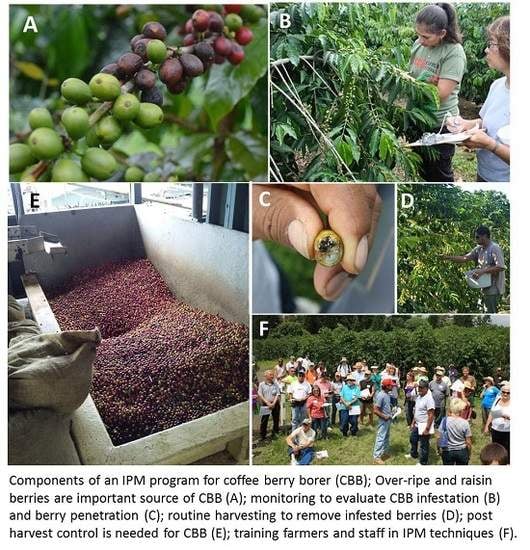Integrated Pest Management of Coffee Berry Borer: Strategies from Latin America that Could Be Useful for Coffee Farmers in Hawaii
Abstract
:1. Introduction
2. Biology, Ecology, and Behavior of CBB
2.1. General Biology of CBB
2.2. Coffee Plant and CBB
2.3. Alternative Host Plants
2.4. Sources and Emergence of CBB
| Farm | CBB | Bb | AB | CD | Mortality | Empty |
|---|---|---|---|---|---|---|
| 1 | 66.4 | 64.5 | 32.7 | 16.3 | 39.4 | 11.4 |
| 2 | 49.9 | 42.3 | 18.8 | 15.9 | 44.9 | 20.2 |
| 3 | 26.7 | 16.4 | 23.8 | 6.8 | 30.6 | 38.6 |
| 4 | 23.1 | 61.9 | 18.0 | 19.4 | 47.2 | 15.4 |
| 5 | 14.7 | 23.8 | 24.4 | 13.9 | 15.1 | 46.5 |
| 6 | 10.2 | 19.7 | 9.4 | 26.4 | 30.1 | 33.9 |
| 7 | 4.2 | 27.5 | 36.3 | 26.3 | 8.0 | 19.0 |
| 8 | 3.3 | 11.0 | 64.8 | 17.8 | 1.9 | 18.2 |
| 9 | 3.2 | 9.3 | 39.3 | 45.4 | 6.0 | 9.0 |
| 10 | 2.9 | 22.0 | 10.0 | 8.0 | 26.0 | 56.0 |
| Average ± SEM | 20.5 ± 6 | 29.8 ± 6 | 27.8 ± 5 | 20.3 ± 3 | 24.9 ± 4 | 26.8 ± 4 |
| 11 * | 81.0 | 44.0 | 18.8 | 13.5 | 52.7 | 18.9 |
| 12 ** | 0.7 | 9.0 | n/a | n/a | n/a | n/a |
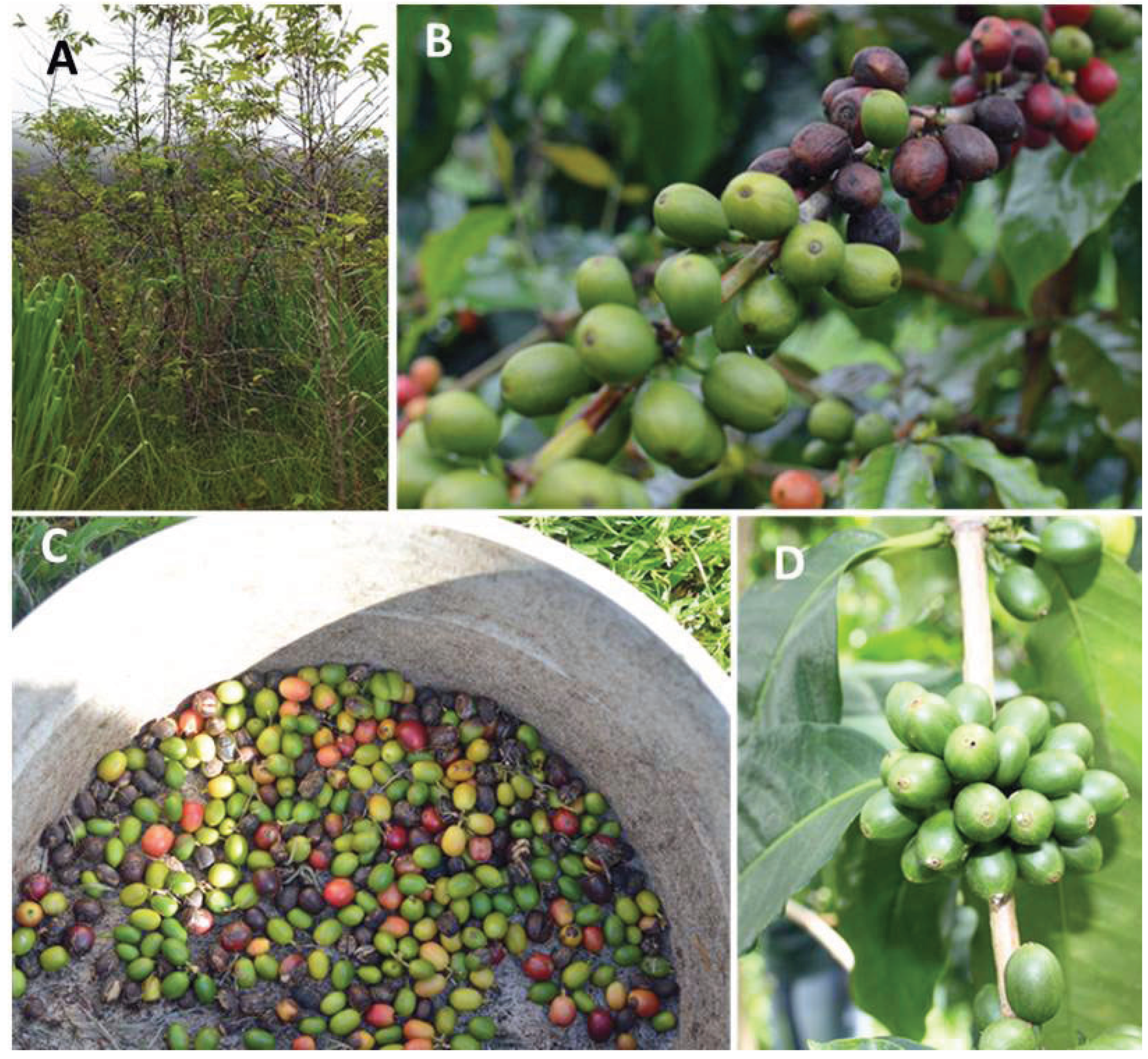
2.5. Visual and Olfactory Attractants of CBB
2.6. Flight and Dispersal of CBB
2.7. Spatial Distribution of CBB
2.8. Effect of Seasonal Rainfall
2.9. Effect of Shade on CBB
3. Strategies on Integrated Pest Management
3.1. Sampling CBB Populations
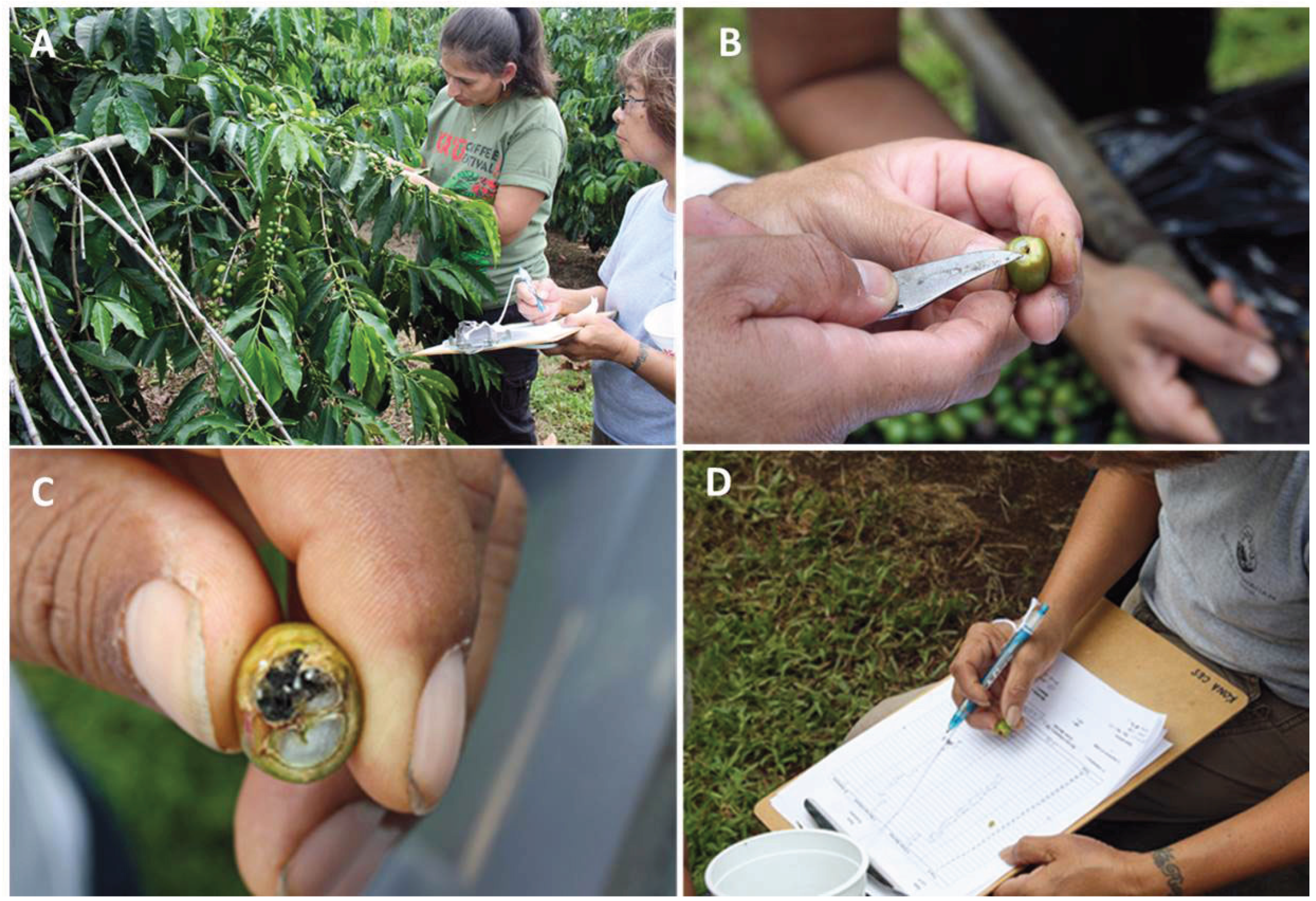
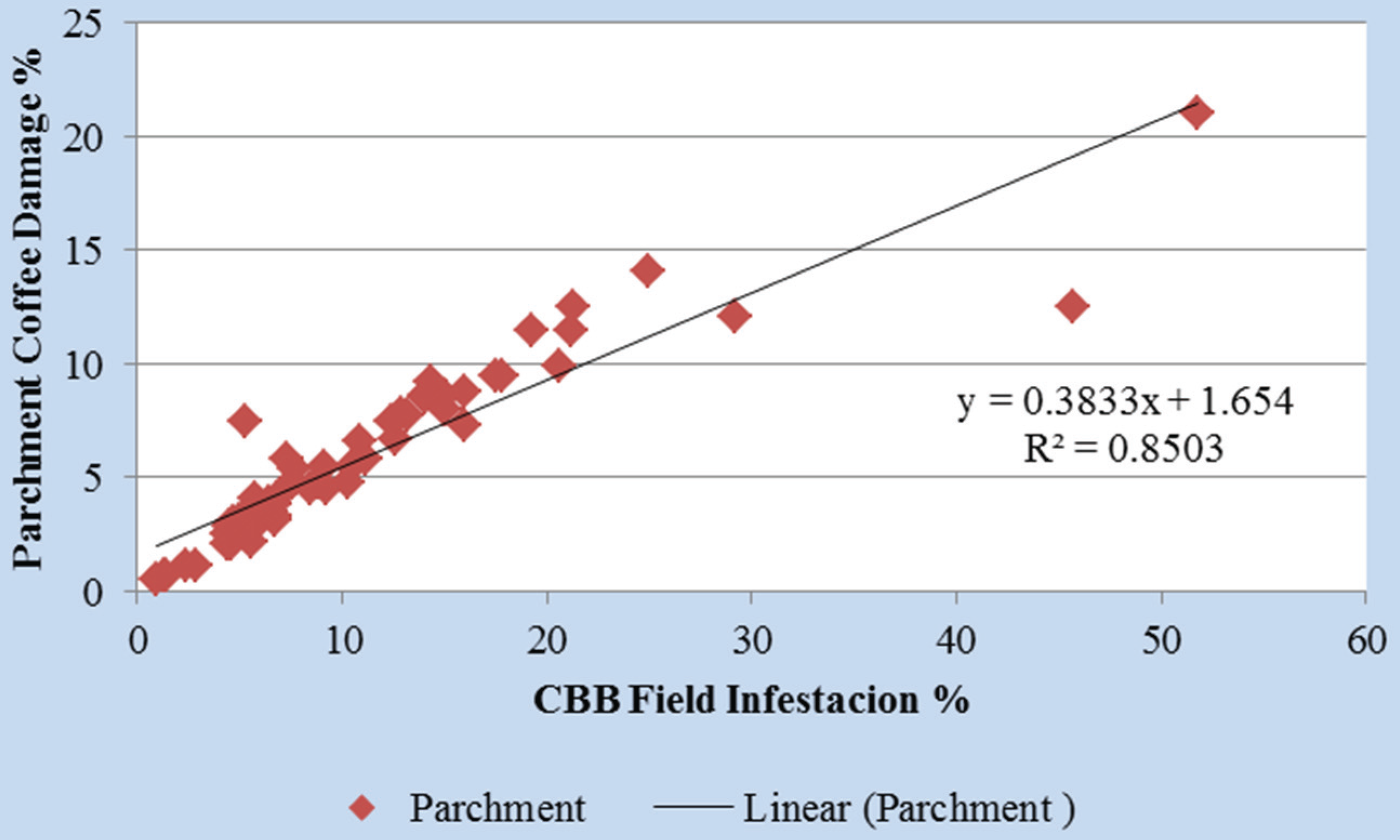
3.2. Monitoring CBB with Alcohol Traps
3.3. Cultural Control Practices
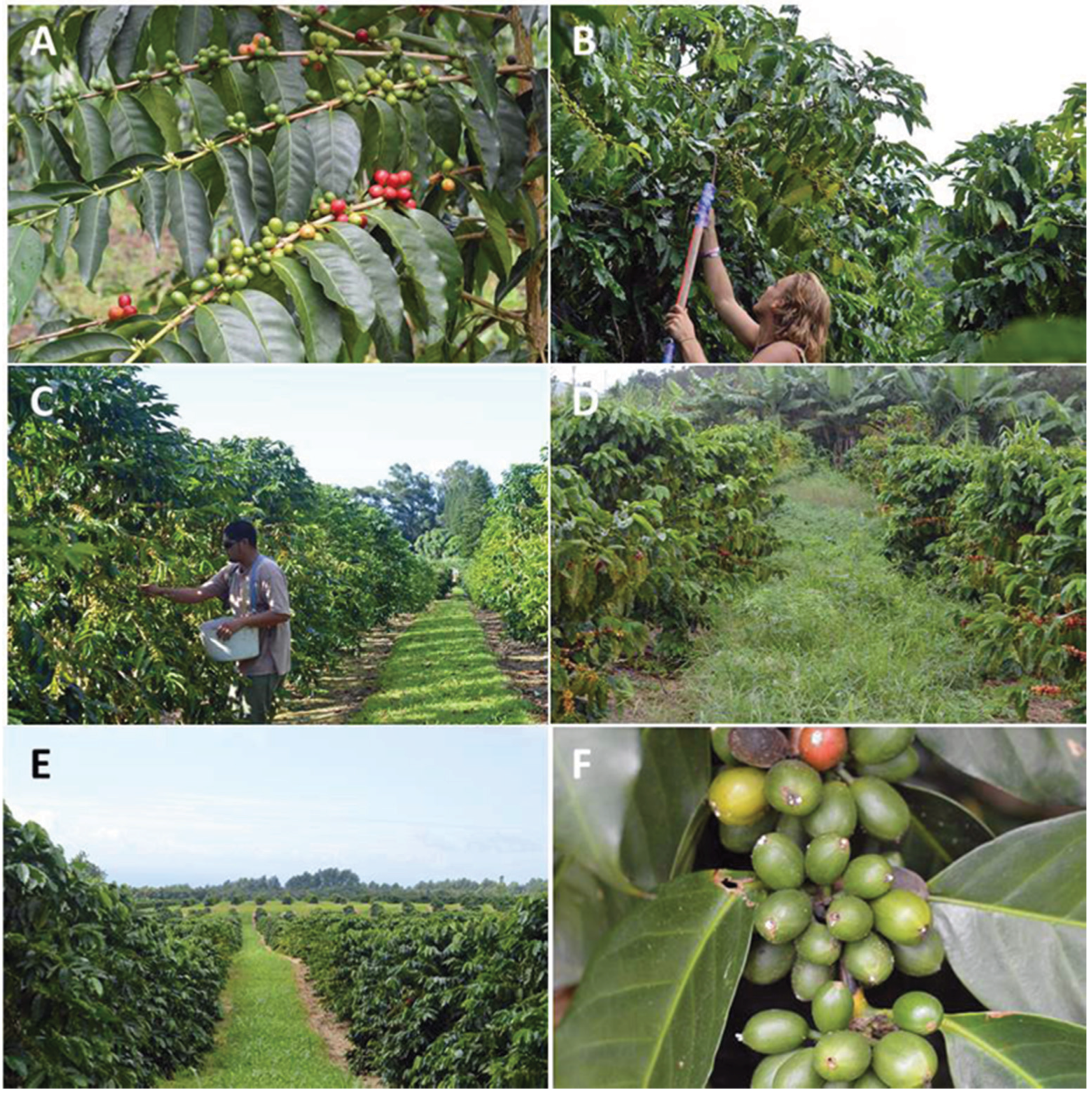
3.4. Use of B. bassiana
3.5. Post-Harvest Control
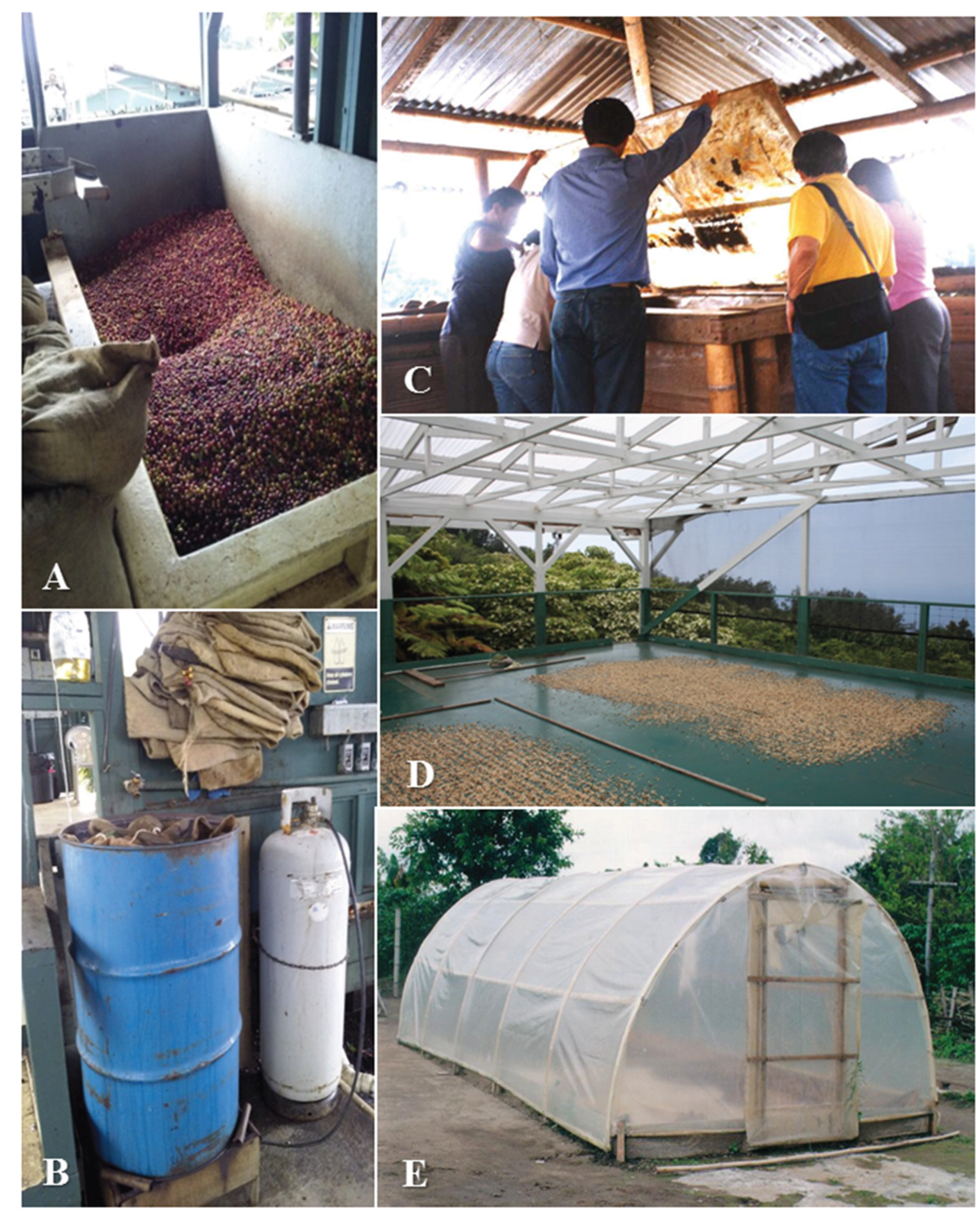
3.6. Natural Enemies of CBB
3.7. Control During “Zoqueo”
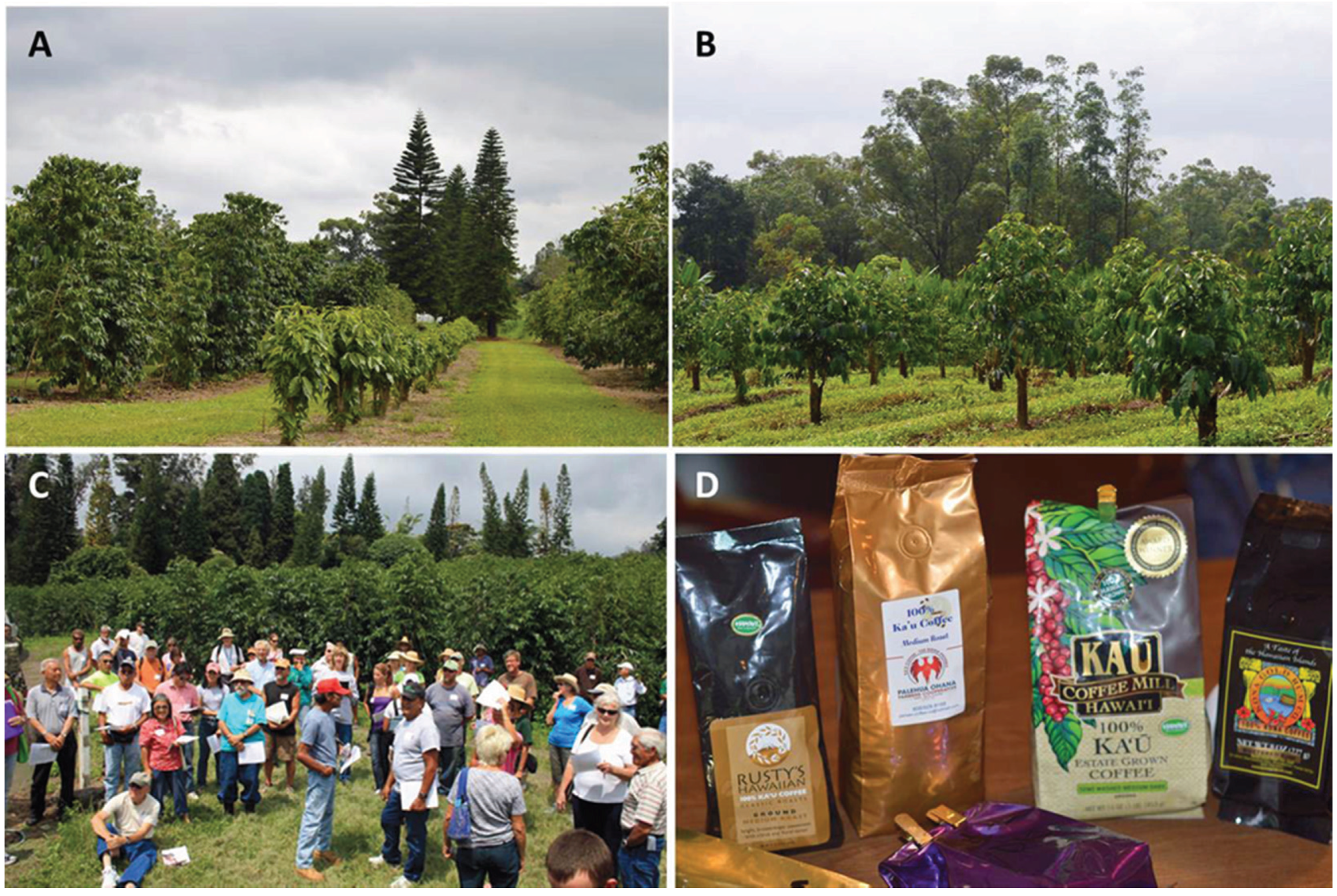
4. General Recommendations
4.1. Recommendation to Coffee Farmers
4.2. Recommendation to Extension Technicians
4.3. Recommendations to Research Centers
5. Conclusions
Acknowledgments
Author Contributions:
Conflicts of Interest
References
- FAOSTAT. Food and Agriculture Organization of the United Nations, Statistics Davison, 2014. Available online: http://faostat.fao.org/ (accessed 20 November 2015).
- Vega, F.E.; Ebert, A.; Ming, R. Coffee germplasm resources, genomic, and breeding. Plant Breed. Rev. 2008, 30, 415–447. [Google Scholar]
- Vega, F.E.; Infante, F.; Johnson, A.J. The genus Hypothenemus, with emphasis on H. hampei, the coffee berry borer. In Bark Beetles, Biology and Ecology of Native and Invasive Species, 1st ed.; Vega, F.E., Hofstetter, R.W., Eds.; Elsevier: London, UK, 2015; Chapter 11; pp. 427–494. [Google Scholar]
- ICO, International Coffee Organization. Coffee trade statistics. Available online: http://www.ico.org/ (accessed on 20 November 2015).
- USDA, United States Department of Agriculture. Coffee: World markets and trade. Available online: http://www.fas.usda.gov/data/coffee-world-markets-and-trade/ (accessed on 20 November 2015).
- Le-Pelley, R.H. Pests of Coffee; Longmans, Green and Co. Ltd.: London, UK, 1968; p. 590. [Google Scholar]
- Bustillo, A.E.; Cárdenas, R.; Villalba, D.; Benavides, P.; Orozco, J.; Posada, F. Manejo Integrado de la Broca del Café, Hypothenemus hampei (Ferrari) en Colombia, 1st ed.; Cenicafé: Chinchiná, Colombia, 1998; p. 134. [Google Scholar]
- Baker, P. The Coffee Berry Borer in Colombia. DFID-Cenicafé CABI Bioscience IPM for coffee Project (CNTR 93/1536A); Cenicafé: Chinchiná, Colombia, 1999; p. 154. [Google Scholar]
- Damon, A. A review of the biology and control of the coffee berry borer, Hypothenemus hampei (Coleoptera: Scolytidae). Bull. Entomol. Res. 2000, 90, 453–465. [Google Scholar] [CrossRef] [PubMed]
- Burbano, E.; Wright, M.; Bright, D.E.; Vega, F.E. New record for the coffee berry borer, Hypothenemus hampei, in Hawaii. J. Insect Sci. 2011. [Google Scholar] [CrossRef] [PubMed]
- Baker, P.S. Some aspects of the behavior of the coffee berry borer in relation to its control in southern Mexico (Coleoptera: Scolytidae). Folia Entomol. Mexicana 1984, 62, 9–24. [Google Scholar]
- Klein-Koch, C. Natural regulation factors and classical biological control of the coffee berry borer (Hypothenemus hampei Ferrari) in Ecuador. In Proceedings of the International DLG-Symposium on Integrated Pest Management in Tropical and Subtropical Systems, Bad Dürkheim, Germany, 8–15 February 1990; pp. 331–334.
- Cárdenas, M.R.; Bustillo, A.E. La broca del café en Colombia. In Proceedings of the Resúmenes, I Reunión Internacional Sobre la Broca del Café, Tapachula, Chiapas, México, 17–22 de noviembre de 1991; Barrera, J.F., Castillo, A., Gómez, J., Malo, E., Infante, F., Eds.; pp. 42–44. (In Spanish)
- Monterrey, J. La broca del café en Nicaragua. In Proceedings of the Resúmenes, I Reunión Internacional Sobre la Broca del Café, Tapachula, Chiapas, México, 17–22 de noviembre de 1991; Barrera, J.F., Castillo, A., Gómez, J., Malo, E., Infante, F., Eds.; pp. 28–30. (In Spanish)
- Bergamin, J. Contribuição para o conhecimento da biologia da broca do café Hypothenemus hampei (Ferrari, 1867) (Col. Ipidae). Arquivos do Instituto Biologico São Paulo 1943, 14, 31–72. (In Portuguese) [Google Scholar]
- Decazy, B. Descripción, biología, ecología y control de la broca del fruto del cafeto, Hypothenemus hampei (Ferr.). In Proceedings of the 50 años de Cenicafé 1938–1988, Conferencias Conmemorativas; Cenicafé, Chinchiná, Colombia, 14 de octubre al 18 de noviembre 1990; pp. 133–139. (In Spanish)
- Jaramillo, J.; Borgemeister, C.; Baker, P. Coffee berry borer Hypothenemus hampei (Coleoptera: Curculionidae): Searching for sustainable control strategies. Bull. Entomol. Res. 2006, 96, 223–233. [Google Scholar] [CrossRef] [PubMed]
- Vega, F.E.; Infante, F.; Catillo, A.; Jaramillo, J. The coffee berry borer, Hypothenemus hampei (Ferrari) (Coleoptera: Curculionidae): A short review, with recent finding and future research directions. Terrestr. Arthr. Rev. 2009, 2, 129–147. [Google Scholar]
- Ruiz-Cárdenas, R.; Baker, P. Life table of Hypothenemus hampei (Ferrari) in relation to coffee berry phenology under Colombian field conditions. Sci. Agric. 2010, 67, 658–668. [Google Scholar] [CrossRef]
- Barrera, J.F. Dynamique des Populations du Scolyte des Fruits du Caffeé, Hypothenemus hampei (Coleoptera: Scolytidae), et lute Biologique avec le Parasitoide Cephalonomia stephanoderis (Hymenoptera: Bethylidae), au Chiapas, Mexique. Ph.D. Thesis, Université Paul Sabatier, Toulouse, France, 1994; p. 301. [Google Scholar]
- Baker, P.S.; Barrera, J.F.; Rivas, A. Life-history studies of the coffee berry borer (Hypothenemus hampei, Scolytidae) on coffee trees in southern Mexico. J. Appl. Entomol. 1992, 29, 656–662. [Google Scholar] [CrossRef]
- Brun, L.O.; Stuart, J.; Gaudchon, V.; Aronstein, K.; French-Constant, R.H. Functional haplodiploidy: A mechanism for the spread of insecticide resistance in an important international insect pest. Proc. Natl. Acad. Sci. USA 1995, 92, 9861–9865. [Google Scholar] [CrossRef] [PubMed]
- Jaramillo, J.; Chabi-Olaye, A.; Kamonjo, C.; Jaramillo, A.; Vega, F.E.; Poehling, H.M.; Borgemeister, C. Thermal tolerance of the coffee berry borer Hypothenemus hampei: Predictions of climate change on a tropical insect pest. PLoS ONE 2009, 4, e6487. [Google Scholar] [CrossRef] [PubMed]
- Muñoz, R. Ciclo biológico y reproducción partenogenética del cafeto, Hypothenemus hampei (Ferr.). Turrialba 1989, 39, 415–421. (In Spanish) [Google Scholar]
- Giordanengo, P. Biologie, Eco-éthologie et Dynamique des Poppulations du Scolyte des Grains de café, Hypothenemus hampei Ferr. (Coleoptera: Scolytidae), en Nouvelle-Calédonie. Ph.D. Thesis, Université de Rennes I, Rennes, France, 1992. [Google Scholar]
- Arcila, J.; Jaramillo, A.; Baldión, V.; Bustillo, A.E. La floración del cafeto y su relación con el control de la broca. Avances Técnicos Cenicafé 1993, 193, 1–6. (In Spanish) [Google Scholar]
- Camayo, G.C.; Arcila, J. Desarrollo floral del cafeto en condiciones de la zona cafetera colombiana (Chinchiná-Caldas). Avances Técnicos Cenicafé 1997, 245, 1–8. (In Spanish) [Google Scholar]
- Vélez, B.E.; Jaramillo, A.; Cháves, B.; Franco, M. Distribución de la floración y la cosecha de café en tres altitudes. Avances Técnicos Cenicafé 2000, 272, 1–4. (In Spanish) [Google Scholar]
- Jaramillo, A.; Guzmán, O. Relación entre la temperatura y el crecimiento en Coffea arabica L. variedad caturra. Rev. Cenicafé 1984, 35, 57–65. (In Spanish) [Google Scholar]
- Salazar, M.R.; Arcila, J.; Riaño, N.; Bustillo, A.E. Crecimiento y desarrollo del fruto del café y su relación con la broca. Avances Técnicos Cenicafé 1993, 194, 1–4. (In Spanish) [Google Scholar]
- Ruiz, R. Efecto de la Fenología del Fruto del café Sobre los Parámetros de la Tabla de vida de la Broca del Café; Hypothenemus hampei (Ferrari). B.Sc. Thesis, Universidad de Caldas, Manizales, Colombia, 1996; p. 87. [Google Scholar]
- Aristizábal, L.F. Efecto del Parasitoide Cephalonomia stephanoderis (Betrem) (Hymenoptera: Bethylidae) Sobre una Población de Hypothenemus hampei (Coleoptera: Scolytidae) en Condiciones de campo. B.Sc. Thesis, Universidad de Caldas, Manizales, Colombia, 1995; p. 129. [Google Scholar]
- Bustillo, A.E. El manejo de cafetales y su relación con el control de la broca del café en Colombia, 1st ed.; FNC-Cenicafé: Chinchiná, Colombia, 2002; p. 40. (In Spanish) [Google Scholar]
- Sponagel, K.W. La broca del Café Hypothenemus hampei en Plantaciones de Café Robusta en la Amazonía Ecuatoriana. Ph.D. Thesis, Universidad de Giessen, Giessen, Germany, 1994; p. 279. [Google Scholar]
- Messing, R.H. The coffee berry borer (Hypothenemus hampei) invades Hawaii: Preliminary investigations on trap response alternate hosts. Insects 2012, 3, 640–652. [Google Scholar] [CrossRef] [PubMed]
- Baker, P.S.; Ley, C.; Balbuena, R.; Barrera, J.F. Factors affecting the emergence of Hypothenemus hampei (Coleoptera: Scolytidae) from coffee berries, Mexico. Bull. Entomol. Res. 1992, 82, 145–150. [Google Scholar] [CrossRef]
- Jaramillo, J.; Chabi-Olaye, A.; Borgemeister, C. Temperature dependent development and emergence pattern of Hypothenemus hampei (Coleoptera: Curculionidae: Scolytinae) from coffee berries. J. Econ. Entomol. 2010, 103, 1159–1165. [Google Scholar] [CrossRef] [PubMed]
- Castaño, A.; Benavides, P.; Baker, P.S. Dispersión de Hypothenemus hampei en cafetales zoqueados. Revista Cenicafé 2005, 56, 142–150. (In Spanish) [Google Scholar]
- Kawabata, A.M.; Nakamoto, S.T.; Curtiss, R.T. Recommendations for coffee berry borer integrated pest management in Hawai’i 2015. Available online: http://www.ctahr.hawaii.edu/oc/freepubs/pdf/IP-33.pdf (accessed on 8 August 2015).
- Ticheler, J.H.G. Estudio analítico de la epidemiología del escolítido de los granos de café, Stephanoderis hampei Ferr., en Costa de Marfil (Traducción G. Quiceno). Rev. Cenicafé 1963, 14, 223–294. (In Spanish) [Google Scholar]
- Mendoza, J.R.; Gomes de Lima, J.O.; Vilela, E.F.; Fantón, C.J. Atratividade de Frutos à Broca-do-Café, Hypothenemus hampei (Ferrari): Estímulos Visuais e Olfativos; Anais: Londrina, Brasil, 2000; UFPR-IAPAR-IRD; pp. 313–331. (In Portuguese) [Google Scholar]
- Mathieu, F.; Gaudichon, V.; Brun, L.O.; Frérot, B. Effect of physiology status on olfactory and visual responses of females Hypothenemus hampei during host plant colonization. Physiol. Entomol. 2001, 26, 186–193. [Google Scholar] [CrossRef]
- Vega, F.E.; Simpkins, A.; Bauchan, G.; Infante, F.; Kramer, M.; Land, M.F. On the eyes of male coffee berry borers as rudimentary organs. PLoS ONE 2014, 9, e85860. [Google Scholar]
- Giordanengo, P.; Brun, L.O.; Frérot, B. Evidence for allelochemical attraction of the coffee berry borer Hypothenemus hampei, by coffee berries. J. Chem. Ecol. 1993, 19, 763–769. [Google Scholar] [CrossRef] [PubMed]
- Mandelsham, M.Y.; Wood, S.L. Bark and ambrosia beetles of South America (Coleoptera: Scolytidae), Brigham Young University, Provo. 2007, p. 900. Available online: http://www.maik.ru/abstract/enteng/9/enteng0245_abstract.pdf (accessed on 3 July 2015).
- Mendesil, E.; Bruce, T.J.A.; Woodcock, C.M.; Caulfield, J.C.; Seyoum, E.; Pickett, J.A. Semiochemicals used in host location by the coffee berry borer Hypothenemus hampei. J. Chem. Ecol. 2009, 35, 944–950. [Google Scholar] [CrossRef] [PubMed]
- Cruz, R.E.N.; Malo, E.A. Chemical analysis of coffee berry borer volatiles that elicit an antennal response from the coffee berry borer Hypothenemus hampei. J. Mexican Chem. Soc. 2013, 57, 321–327. [Google Scholar]
- Ortiz, A.; Vega, F.E.; Posada, F.J. Volatile composition of coffee berries at different stages of ripeness, and their possible attraction to the coffee berry borer Hypothenemus hampei (Coleoptera: Curculionidae). J. Agric. Food Chem. 2004, 52, 5914–5918. [Google Scholar] [CrossRef] [PubMed]
- Gutierrez-Martinez, A.; Ondarza, R.N. Kairomone effect of extracts from Coffea canephora over Hypothenemus hampei by coffee berries. J. Chem. Ecol. 1996, 25, 96–100. [Google Scholar]
- Borbón, O.; Mora, A.O.; Oehlschlager, A.C.; González, L.M. Proyecto de Trampas, Atrayentes y Repelentes para el Control de la Broca del Fruto de Cafeto, Hypothenemus hampei (Ferrari) (Coleoptera: Scolytidae); Informe ICAFE: San José, Costa Rica, 2002; p. 18. (In Spanish) [Google Scholar]
- Dufour, B.P.; Frérot, B. Optimization of coffee beery borer, Hypothenemus hampei Ferrari (Coleoptera: Scolytidae), mass trapping with an attractant mixture. J. Appl. Entomol. 2008, 132, 591–600. [Google Scholar] [CrossRef]
- Silva, F.C.D.; Ventura, M.U.; Mikami, A.Y.; da Silva, F.C.; Morales, L. Capture of Hypothenemus hampei Ferrari (Coleoptera: Scolytidae) in response to trap characteristics. Sci. Agric. 2006, 63, 567–571. [Google Scholar] [CrossRef]
- Fernandes, F.L.; Pocanço, M.C.; Campos, S.O.; Bastos, C.S.; Chediak, M.; Guedes, R.N.C.; Da Silva, R.S. Economic injury level for the coffee berry borer (Coleoptera, Curculionidae: Scolytinae) using attractive traps in Brazilian coffee fields. J. Ecol. Entomol. 2011, 104, 1909–1917. [Google Scholar] [CrossRef]
- Aristizábal, L.F.; Jiménez, M.; Bustillo, A.E.; Trujillo, H.I.; Arthurs, S.P. Monitoring coffee berry borer, Hypothenemus hampei (Coleoptera: Curculionidae), populations with alcohol-baited funnel traps in coffee farm in Colombia. Fla. Entomol. 2015, 98, 381–383. [Google Scholar] [CrossRef]
- Ochoa, H.; Decazy, B.; Lotode, R. Estudio de un tipo de muestreo para determinar el índice de combate de la broca del café Hypothenemus hampei Ferr. Rev. Cafetalera 1988, 287, 16–25. (In Spanish) [Google Scholar]
- Klein-Koch, C.; Espinoza, O.; Tandazo, A.; Cisneros, P.; Delgado, D. Factores naturales de regulación y control biológico de la broca del café (Hypothenemus hampei Ferr.). Sanidad Vegetal 1988, 3, 5–30. (In Spanish) [Google Scholar]
- Vega, F.E.; Mercadier, G.; Damon, A.; Kirk, A. Natural enemies of the coffee berry borer, Hypothenemus hampei (Ferrari) (Coleoptera: Scolitidae) in Togo and Ivory Coast, and additional entomofauna associated with coffee beans. Afr. Entomol. 1999, 7, 243–248. [Google Scholar]
- Mendes, C.T. A broca do café. Revista Agric. (Piracicaba) 1938, 13, 405–423. (In Portuguese) [Google Scholar]
- Fonseca, J.P. A “bróca” e o sombreamento dos cafezais. O Biologico (Brazil) 1939, 5, 1336. Rev. Appl. Entomol., Ser. A 1940, 28–61. (In Portuguese) [Google Scholar]
- Hargreaves, H. Coffee-pests. In Agriculture in Uganda; Tothill, J.D., Ed.; Oxford University Press: London, UK, 1940; pp. 340–380. [Google Scholar]
- Féliz Matos, D.; Guharay, F.; Beer, J. Incidencia de la broca (Hypothenemus hampei) en plantas de café a pleno sol y bajo sombra de Eugenia jambos y Gliricidia sepium en San Marcos, Nicaragua. Agrofor. Am. 2004, 41/42, 56–61. (In spanish) [Google Scholar]
- Bosselmann, A.S.; Dons, K.; Oberthur, T.; Olsen, C.S.; Reabild, A.; Usma, H. The influence of shade trees on coffee quality in small holder coffee agroforestry in Southern Colombia. Ecosyst. Environ. 2009, 129, 253–260. [Google Scholar] [CrossRef]
- Aristizábal, L.F.; Mid-Florida Research and Education Center, University of Florida, Apopka, FL, USA. Personal Communication, 2015.
- Salazar, E.H.M.; Aristizábal, L.F.; Mejía, C.G. Investigación participativa con caficultores en relación con el manejo integrado de la broca del café Hypothenemus hampei (Ferrari) (Coleoptera: Scolytidae) durante el proceso de beneficio. Rev. Colomb. Entomol. 2003, 29, 57–62. (In Spanish) [Google Scholar]
- Bustillo, P.A.E. Una revisión sobre la broca del café, Hypothenemus hampei (Coleoptera: Curculionidae, Scolytinae), en Colombia. Rev. Colomb. Entomol. 2006, 32, 101–116. (In Spanish) [Google Scholar]
- Jaramillo, J.; Bustillo, A.E.; Montoya, E.C.; Borgemeister, C. Biological control of the coffee berry borer Hypothenemus hampei (Ferrari) (Coleoptera: Curculionidae, Scolytinae) by Phymastichus coffea LaSalle (Hymenoptera: Eulophidae) in Colombia. Bull. Entomol. Res. 2005, 95, 1–6. [Google Scholar] [CrossRef]
- Benavides, P.; Bustillo, A.E.; Montoya, E.C.; Cárdenas, R.; Mejía, C.G. Participación del control cultural, químico y biológico en el manejo de la broca del café. Rev. Colomb. Entomol. 2002, 28, 161–166. (In Spanish) [Google Scholar]
- Aristizábal, L.F.; Lara, O.; Arthurs, S.P. Implementing an integrated pest management for coffee berry borer in a specialty coffee plantation in Colombia. J. Integ. Pest Mngmt. 2012. [Google Scholar] [CrossRef]
- Pérez, J.; Infante, F.; Vega, F.E. A coffee berry borer (Coleoptera, Curculionidae: Scolytinae) bibliography. J. Insect Sci. 2015. [Google Scholar] [CrossRef] [PubMed]
- Zelaya, R.R.; Vargas, J.C. Rentabilidad del control cultural de la broca del fruto del cafeto (H. hampei) en parcelas de comprobación. In Proceedings of the Taller Regional de Broca (3), IICA-Promecafé, Antigua, Guatemala, 3–7 Abril 1989; pp. 97–102. (In Spanish)
- Villanueva, E. Efectividad del control manual y químico para la broca del café, H. hampei en el Soconusco, Chiapas, México. In Proceedings of the Taller Regional sobre la Broca del Fruto del Cafeto (4), IICA-Promecafé, San Salvador, El Salvador, 1990. (In Spanish)
- Duque, H.; Baker, P. Devouring Profit; The Soci-Econimics of Coffee Berry Borer IPM; The Commodities Press: CABI-Biosciense, Cenicafé, Chinchiná & Colombia, 2003. [Google Scholar]
- Aristizábal, L.F.; Jiménez, M.; Bustillo, A.E.; Arthurs, S.P. Monitoring cultural practices for coffee berry borer Hypothenemus hampei (Coleoptera: Curculionidae: Scolytinae) management in a small coffee farm in Colombia. Fla. Entomol. 2011, 94, 686–687. [Google Scholar]
- Woodill, A.J.; Hemachandra, D.; Nakamoto, S.T.; Leung, P.S. The economics of coffee production in Hawai’i. College of Tropical Agriculture and Human Resources, University of Hawai’i. Economic Issues, July 2014. EI-25. 2014; 1–9. [Google Scholar]
- Shriner, Z.; Synergistic Hawaii Ag Council, Kona Hongwanji, HI, USA. Personal Communication, 2016.
- Aristizábal, L.F.; Salazar, H.M.; Mejia, C.G. Cambios en la adopción de los componentes del manejo integrado de la broca del café, Hypothenemus hampei (Coleoptera: Scolytidae) a través de metodologías participativas. Rev. Colomb. Entomol. 2002, 28, 153–160. (In Spanish) [Google Scholar]
- Kogan, M. Integrated pest management: Historical perspectives and contemporary developments. Ann. Rev. Entomol. 1998, 43, 243–270. [Google Scholar] [CrossRef] [PubMed]
- Barrera, J.F.; Infante, F.; Gómez, J.; de la Rosa, W. Guía Práctica Umbrales Económicos para el Control de la Broca del Café; Centro de Investigaciones Ecológicas del Sureste: Tapachula, Chiapas, México, 1993; p. 50. (In Spanish) [Google Scholar]
- Muñoz, R. Muestreo en fincas para determinar la población de broca (Hypothenemus hampei Ferr.) y metodología para calcular el nivel de daño económico. Boletín de PROMECAFE, 1988, 38, 4–14. (In Spanish) [Google Scholar]
- Baker, P.S. A sampling plan for a control project against the coffee berry borer (Hypothenemus hampei) in Mexico. Tropical Pest Mngmt. 1989, 35, 169–172. [Google Scholar] [CrossRef]
- Decazy, B. Métodos de muestreo para la determinación de poblaciones críticas de la broca del fruto del cafeto Hypothenemus hampei (Ferr.). pp. 140–145. In Proceedings of the 50 años de Cenicafé 1938–1988, Conferencias Conmemorativas; Cenicafé, Chinchiná, Colombia, 14 de octubre al 18 de noviembre 1990; p. 255. (In Spanish)
- Segura, H.R.; Barrera, J.F.; Morales, H.; Nazar, A. Farmer’s perceptions, knowledge, and management of coffee pest and diseases and their natural enemies in Chiapas, Mexico. J. Econ. Entomol. 2004, 97, 1491–1499. [Google Scholar] [CrossRef] [PubMed]
- Trujillo, E.H.I.; Aristizábal, A.L.F.; Bustillo, P.A.E.; Jiménez, Q.M. Evaluación de métodos para cuantificar poblaciones de broca del café, Hypothenemus hampei (Ferrari) (Coleoptera: Curculionidae: Scolytinae) en fincas de caficultores experimentadores. Rev. Colomb. Entomol. 2006, 32, 39–44. (In Spanish) [Google Scholar]
- Aristizábal, L.F. Mid-Florida Research and Education Center, University of Florida: Apopka, FL, USA, Unpublished data. 2015.
- Pereira, A.E.; Vilela, E.F.; Tinoco, R.S.; De Lima, J.O.G.; Fantine, A.K.; Morais, E.G.; França, C.F. Correlation between number captured and infestation levels of the coffee berry borer, Hypothenemus hampei: A preliminary basis for an action threshold using baited traps. Int. J. Pest Mngmt. 2012, 58, 183–190. [Google Scholar] [CrossRef]
- Mathieu, F.; Brun, L.O.; Marcillaud, C.; Frérot, B. Trapping of the coffee berry borer within a mesh-enclosed environment: Interaction of olfactory and visual stimuli. J. Appl. Entomol. 1997, 121, 181–186. [Google Scholar] [CrossRef]
- Dufour, B. Importance du piégeage pour la lutte intégrée contre le scolyte du café, Hypothenemus hampei (Ferr.). Available online: http://agritrop.cirad.fr/508307/ (accessed on 8 July 2015). (In French)
- Fernández, F.L.; Cordero, J. Evaluación de atrayentes alcohólicos en trampas artesanales para el monitoreao de la broca del cafe, Hypothenemus hampei (Ferrari) . Bioagro 2005, 17, 143–148. (In Spanish) [Google Scholar]
- Barrera, J.F.; Herrera, J.; Chiu, M.; Gómez, J.; Valle Mora, J. La trampa de una ventana (ECOIAPAR) captura más broca del café Hypothenemus hampei que la trampa de tres ventanas (ETOTRAP). Entomol. Mexicana 2008, 7, 610–624. (In Spanish) [Google Scholar]
- Uemura-Lima, D.H.; Ventura, M.U.; Mikami, A.Y.; da Silva, F.C.; Morales, L. Response of coffee berry borer, Hypothenemus hampei (Ferrari) (Coleoptera: Scolytidae) to vertical distributions of methanol: Ethanol traps. Neotrop. Entomol. 2010, 39, 930–933. [Google Scholar] [CrossRef] [PubMed]
- Chamorro, T.G.; Cárdenas, R.; Herrera, H.A. Evaluación económica y de la calidad en taza del café proveniente de diferentes sistemas de recolección manual, utilizables como control en cafetales infestados de Hypothenemus hampei. Rev. Cenicafé 1995, 46, 164–175. (In Spanish) [Google Scholar]
- Saldarriaga, A.G. Evaluación Prácticas Culturales en el Control de la Broca del café, Hypothenemus hampei (Ferrari 1867) (Coleoptera: Scolytidae). BSc. Thesis, Universidad Nacional de Colombia, Medellín, Colombia, 1994; p. 57. [Google Scholar]
- Peralta, J. Diagnóstico de la Labor de Recolección y Repase Para el Manejo de la Broca del café Hypothenemus hampei (Ferrari) (Coleoptera: Scolytidae) por Agricultores. B.Sc. Thesis, Universidad Nacional de Colombia, Palmira, Colombia, 1995; p. 71. [Google Scholar]
- Díaz, Y.; Marín, H.F. Evaluación de los Frutos de Café Dejados Después de las Recolecciones Durante un Ciclo Productivo del Cultivo en dos Municipios del Departamento de Caldas. BSc. Thesis, Universidad de Caldas. Manizales, Colombia, 1999; p. 96. [Google Scholar]
- Aristizábal, L.F.; Bustillo, A.E.; Jiménez, M.; Trujillo, H.I.V. Encuentro de caficultores experimentadores. Manejo integrado de la broca del café a través de investigación participativa; Convenio Colciencias-FNC-Cenicafé-Fundación Manuel Mejía. Cenicafé: Chinchiná, Colombia, 2004; p. 70. (In Spanish) [Google Scholar]
- Bergamin, J. O “repase” como método de controle da broca do café “Hypothenemus hampei (Ferr., 1867)” (Col. Ipidae). Arq. Inst. Biol. Sao Paulo 1944, 15, 197–208. (In Portuguese) [Google Scholar]
- Mesquina, F. de C. A broca do café no Estado do Rio de Janeiro. Biletim Fitossanitarío 1944, 1, 247–253. (In Portuguese) [Google Scholar]
- Villacorta, A. Ocurrencia de Beauveria sp. Infectando a broca do café-Hypothenemus hampei (Ferrari 1867) (Coleoptera: Scolytidae) em lavouras no estado do Paraná. An. Soc. Entomol. Bras. 1984, 13, 177–178. (In Portuguese) [Google Scholar]
- Vélez-Arango, P.E.; Benavides-Gómez, M. Registro e identificación de Beauveria bassiana en Hypothenemus hampei en Ancuya, Departamento de Nariño, Colombia. Rev. Cenicafé 1990, 41, 50–57. (In Spanish) [Google Scholar]
- Lazo, A.R.R. Susceptibilidad de la Broca del Fruto del Cafeto (Hypothenemus hampei) al Hongo Entomopatógeno Beauveria bassiana, y su Tolerancia a Oxicloruro de Cobre. M.Sc. Thesis, Centro Agronómico Tropical de Investigación y Enseñanza, Turrialba, Costa Rica, 1990; p. 61. [Google Scholar]
- Méndez-López, I. Control Microbiano de la Broca del Fruto del Cafeto Hypothenemus hampei Ferrari (Coleoptera: Scolytidae), en el Soconusco, Chiapas. M.Sc. Thesis, Colegio de Postgrados, Chapingo, México, 1990; p. 135. [Google Scholar]
- Echeverría, B.F. Caracterización Biológica y Molecular de Asilamientos del Hongo Entomopatógeno Beauveria bassiana (Balsamo). Vuillemin. B.Ss. Thesis, Escuela de Biología, Instituto Tecnológico de Costa Rica, Cartago, Costa Rica, 2006; p. 92. [Google Scholar]
- Gallardo-Covas, F.; Hernández, E.; Pagán, J. Presencia natural del hongo Beauveria bassiana (Bals.) Vuill. En la broca del fruto del café Hypothenemus hampei (Ferrari) en Puerto Rico. J. Agric. Univ. 2010, 94, 195–198. (In Spanish) [Google Scholar]
- Costa, J.N.M.; da Silva, R.B.; de Araújo Ribeiro, P.; Garcia, A. Ocorrencia de Beauveria bassiana (Bals.) Vuill. sEm broca-do-café (Hypothenemus hampei, Ferrari) no estado de Rondonia, Brasil. Acta Amazon. 2002, 32, 517–519. (In Portuguese) [Google Scholar] [CrossRef]
- Monzón, A.J.; Guharay, F.; Klingen, I. Natural occurrence of Beauveria bassiana in Hypothenemus hampei (Coleoptera: Curculionidae) population in unsprayed coffee fields. J. Invertebr. Pathol. 2008, 97, 134–141. [Google Scholar] [CrossRef] [PubMed]
- Balakrishnam, M.M.; Sreedharan, K.; Krishnammoorthy Bhat, P. Occurrence of the entomopathogenic fungus Beauveria bassiana on certain coffee pests in India. J. Coffee Res. 1994, 24, 33–35. [Google Scholar]
- Mbang, J.A.à.; Mounjouenpou, P.; Mahob, R.J.; Mbarga, A.M.; Mouen Bedimo, J.; Nyasse, S. Evaluaation naturelle de I’impact de Beauveria bassiana: Champignon entomopathogène dans la dynamique de population de Hypothenemus hampei, scolyte de baies des cerises de Coffea canefora. Afr. Crop. Sci. J. 2012, 20, 443–451. [Google Scholar]
- Vélez, P.E.; Montoya, E.C. Supervivencia del hongo Beauveria bassiana bajo radiación solar en condiciones de laboratorio y campo. Rev. Cenicafé 1993, 44, 111–122. (In Spanish) [Google Scholar]
- Lacayo, L.; Barrios, M.; Jiménez, C.; Sandino, V. El uso de hongos entomopatógenos para el manejo de la broca del café (Hypothenemus hampei) en Nicaragua. Ministerio de Agricultura y Ganadería. Managua, Nicaragua. Available online: http://naples-fl-real-estate.info/Record/434679 (accessed on 3 August 2015). (In Spanish)
- Posada, F.F.J.; Salazar, E.H.M.; Aristizábal, A.L.F.; Mejía, C.G.; Jiménez, M. Taller con caficultores en el control de Hypothenemus hampei (Ferrari) (Coleoptera: Scolytidae). Rev. Colomb. Entomol. 2003, 29, 63–70. (In Spanish) [Google Scholar]
- Vega, F.E.; Meyling, N.V.; Luangsa-ard, J.J.; Blackwll, M. Fungal entomopathogens pp. In Insect Pahology, 2nd ed.; Vega, F.E., Kaya, H.K., Eds.; Academic Press: San Diego, CA, USA, 2012; pp. 170–220. [Google Scholar]
- Bustillo, A.E.; Castillo, H.; Villalba, D.; Morales, E.; Vélez, P. Evaluaciones de campo con el hongo Beauveria bassiana para el control de la broca del café, Hypothenemus hampei en Colombia. In Proceedings of the ASIC, 14e. Colloque, San Francisco, CA, USA, 14–19 July 1991; pp. 679–686. (In Spanish)
- Flórez, E.; Bustillo, A.E.; Montoya, E.C. Evaluación de equipos de aspersión para el control de Hypothenemus hampei con el hongo Beauveria bassiana. Rev. Cenicafé 1997, 48, 92–98. [Google Scholar]
- Arcila, A.; Bustillo, A.E. Estudios básicos sobre Beauveria bassiana en cafetales de Colombia. In Proceedings of the Informe anual, Disciplina de Entomología, Cenicafé, Chinchiná, Colombia, 1–5 noviembre 1997; p. 22. (In Spanish)
- Benavides, P.; Góngora, C.; Bustillo, A. IPM program to control coffee berry borer Hypothenemus hampei, with emphasis on highly pathogenic mixed strains of Beauveria bassiana, to overcome insecticide resistance in Colombia. In Insecticides-Advances in Integrated Pest Management, 1st ed.; Perveen, F., Ed.; InTech Europe: Rijeka, Croatia, 2012; pp. 512–540. [Google Scholar]
- Cruz, L.P.; Gaitan, A.L.; Góngora, C.E. Exploiting the genetic diversity of Beauveria bassiana for improving the biological control of the coffee berry borer through the use of strain mixture. Appl. Microbiol. Biotechnol. 2006, 71, 918–926. [Google Scholar] [CrossRef] [PubMed]
- Bustillo, A.E.; Bernal, M.G.; Cháves, B.; Benavides, P. Dynamics of Beauveria bassiana and Metarhizium anisopliae infecting Hypothenemus hampei (Coleoptera: Scolytidae) populations emerging from fallen coffee berries. Fla. Entomol. 1999, 82, 491–498. [Google Scholar] [CrossRef]
- Vera, J.T.; Montoya, E.C.; Benavides, P.; Góngora, C.E. Evaluation of Beauveria bassiana (Ascomycota: Hypocreales) as a control of the coffee berry borer Hypothenemus hampei (Coleoptera: Curculionidae: Scolytinae) emerging from fallen, infested coffee on the ground. Biocontrol Sci. Technol. 2011, 21, 1–14. [Google Scholar] [CrossRef]
- Aristizábal, L.F. Investigación participativa en el manejo integrado de la broca del café. In Proceedings of the Memorias XXXII Congreso Sociedad Colombiana de Entomología, Ibagué, Colombia, 27–29 July 2005; pp. 65–71. (In Spanish)
- Posada, F.; Vega, F.E. Inoculation and colonization of coffee seed lings (Coffea arabica L.) with the fungal entomopathogen Beauveria bassiana (Ascomycota: Hypocreales). Mycoscience 2006, 47, 284–289. [Google Scholar] [CrossRef]
- Posada, F.; Aime, M.C.; Peterson, S.W.; Rehner, S.A.; Vega, F.E. Inoculation of coffee plants with the fungal entomopathogen Beauveria bassiana (Ascomycota: Hypocreales). Mycol. Res. 2007, 111, 748–757. [Google Scholar] [CrossRef] [PubMed]
- Vega, F.E.; Posada, F.; Aime, M.C.; Peterson, S.W.; Rehner, S. Fungal endophytes in green coffee seedes. Mycosystema 2008, 27, 75–84. [Google Scholar]
- Hollingsworth, R.G.; Daniel, K.; Inouye, U.S. Pacific Basin Agricultural Research Center, USDA/ARS, Hilo, HI, USA. Personal Communication, 2016. [Google Scholar]
- Wraight, S.; Keith, L. Efficacy of spray applications of Beauveria bassiana strain GHA (BotaniGard®) against coffee berry borer, Hypothenemus hampei, on Hawaii island. In Proceedings of the 63rd Annual Meeting of the Entomological Society of America ESA, Minneapolis, MN, USA, 15–18 November 2015.
- Castro, L.; Benavides, M.P.; Bustillo, P.A.E. Dispersión y mortalidad de Hypothenemus hampei, durante la recolección y benéfico del café. Manejo Integrado de Plagas (Costa Rica) 1998, 50, 19–28. (In Spanish) [Google Scholar]
- Aristizábal, L.F.; Salazar, H.M.; Mejía, C.G. Evaluación del manejo de la broca del café en las tolvas de recibo y en las fosas para la pulpa, mediante investigación participativa. Avances Técnicos Cenicafé 2002, 297, 1–8. (In Spanish) [Google Scholar]
- Hampel, A. A Prorops nasuta Waterston no Brasil. Arquivos Instit. Biol. 1934, 5, 197–212. [Google Scholar]
- Abraham, Y.J.; Moore, D.; Godwin, G. Rearing and aspects of biology of Cephalonomia stephanoderis and Prorops nasuta (Hymenoptera: Bethylidae) parasitoids of the coffee berry borer, Hypothenemus hampei (Coleoptera: Scolytidae). Bull. Entomol. Res. 1990, 80, 121–128. [Google Scholar] [CrossRef]
- Barrera, J.F.; Infante, F.; Castillo, A.; De la Rosa, W.; Gómez, J. Cría y manejo de Cephalonomia stephanoderis y Prorops nasuta parasitoides de la broca del café. In Proceedings of the Seminario sobre la Broca del Cafeto, Miscelánea No. 18, Medellín, Colombia, Socolen, 21 de mayo de 1990; pp. 76–86. (In Spanish)
- Benavides, M.; Portilla, M. Uso del café pergamino para la cría de la broca del café, Hypothenemus hampei y de su parasitoide Cephalonomia stephanoderis Betrem en Colombia. In Proceedings of the Seminario sobre la Broca del Cafeto, Miscelánea No. 18, Medellín, Colombia, Socolen, 21 de mayo de 1990; pp. 87–90. (In Spanish)
- Orozco, J.; Aristizábal, L.F. Parasitoides de origen africano para el control de la broca del café. Avances Técnicos Cenicafé 1996, 223, 1–8. (In Spanish) [Google Scholar]
- Yokoyama, M.; Nakano, O.; Rigitano, R.L.; Nakayama, L. Situatçion actual de vespa de Uganda, Prorops nauta Waterston, 1923 (Hymenoptea: Bethylidae) no Brazil. Cientifica 1977, 5, 394. (In Portuguese) [Google Scholar]
- Cisneros, P.; Tandazo, A. Evidencias sobre el establecimiento del parasitoide Prorops nasuta W. en el suroriente de Ecuador. In Proceedings of the Seminario sobre la Broca del Cafeto, Miscelánea No. 18, Medellín, Colombia, Socolen, 21 de mayo de 1990; pp. 50–57. (In Spanish)
- Campos, A.O.G. Manejo de la broca del café en una finca de producción comercial en Guatemala. In Proceedings of the Simposio sobre Situación Actual y Perspectivas de la Investigación y Manejo de la Broca del Café en Costa Rica, Sociedad Mexicana de Entomología y el Colegio de la Frontera Sur, Tapachula, Chiapas, México, 2005; pp. 38–45. (In Spanish)
- Infante, F.; Mumford, J.; Méndez, I. Non-recovery of Prorops nasuta (Hymenoptera: Bethylidae), an imported parasitoid of the coffee berry borer (Coleoptera: Scolytidae) in Mexico. Southw. Entomol. 2001, 26, 159–163. [Google Scholar]
- Barrera, J.F. Investigaciones sobre la broca del café en México: Logros, retos y perspectivas. In Proceedings of the Simposio sobre Situación Actual y Perspectivas de la Investigación y Manejo de la Broca del Café en Costa Rica. Sociedad Mexicana de Entomología y el Colegio de la Frontera Sur, Tapachula, Chiapas, México, 2005; pp. 1–13. (In Spanish)
- Quintero, C.; Bustillo, A.E.; Benavides, P.; Cháves, B. Evidencias del establecimiento de Cephalonomia stephanoderis y Prorops nasuta (Hymenoptera: Bethylidae) en cafetales del departamento de Nariño, Colombia. Rev. Colomb. Entomol. 1998, 24, 141–147. (In Spanish) [Google Scholar]
- Maldonado, C.E.; Benavides, P. Evaluación del establecimiento de Cephalonomia stephanoderis y Prorops nasuta, controladores de Hypothenemus hampei, en Colombia. Rev. Cenicafé 2007, 59, 333–339. (In Spanish) [Google Scholar]
- Aristizábal, L.F.; Salazar, H.M.; Mejía, C.G.; Jiménez, M.; Bustillo, A.E.; Arthurs, S.P. Establishment of exotic parasitoids of the coffee berry borer Hypothenemus hampei (Coleoptera: Curculionidae: Scolytinae) in Colombia through farmer participatory research. Int. J. Trop. Insect Sci. 2012, 1, 24–31. [Google Scholar] [CrossRef]
- Gómez, J.; Santos, A.; Valle, J.; Montoya, P.J. Determinación del establecimiento de parasitoides de la broca del café Hypothenemus hampei (Coleoptera: Curculionidae: Scolytinae) en cafetales del Soconusco, Chiapas, México. Entomotrópica 2010, 25, 25–36. (In Spanish) [Google Scholar]
- Delgado, D.; Sotomayor, I. Algunos resultados sobre la cría, adaptación y colonización de los entomógenos Prorops nasuta Waters. y Cephalonomia stephanoderis Betrem, en la regulación de poblaciones de H. hampei en el Ecuador. In Proceedings of the Seminario sobre la Broca del Cafeto, Miscelánea No. 18, Medellín, Colombia, Socolen, 21 de mayo de 1990; pp. 58–95. (In Spanish)
- Benavides, P.; Bustillo, A.E.; Montoya, E.C. Avances sobre el uso del parasitoide Cephalonomia stephanoderis para el control de la broca del café, Hypothenemus hampei. Rev. Colomb. Entomol. 1994, 20, 247–253. (In Spanish) [Google Scholar]
- Dufour, B.; Barrera, J.F.; Decazy, B. La broca de los frutos del cafeto: la lucha biológica como solución? In Desafíos de la caficultura Centroamericana; Bertrand, B., Rapidel, B., Eds.; IICA PROMECAFE: San José, Costa Rica, 1999; pp. 293–325. (In Spanish) [Google Scholar]
- Aristizábal, L.F.; Baker, P.S.; Orozco, J.; Cháves, B. Parasitismo de Cephalonomia stephanoderis Betrem sobre una población de Hypothenemus hampei (Ferrari) con niveles bajos de infestación en campo. Rev. Colomb. Entomol. 1997, 23, 157–164. (In Spanish) [Google Scholar]
- Aristizábal, L.F.; Bustillo, A.E.; Orozco, J.; Cháves, B. Efecto del parasitoide Cephalonomia stephanoderis (Hymenoptera: Bethylidae) sobre las poblaciones de Hypothenemus hampei (Coleoptera: Scolytidae) durante y después de la cosecha. Rev. Colomb. Entomol. 1998, 24, 149–155. (In Spanish) [Google Scholar]
- Salazar, H.M.; Baker, P.S. Impacto de liberaciones de Cephalonomia stephanoderis sobre poblaciones de Hypothenemus hampei. Rev. Cenicafé 2002, 53, 306–316. (In Spanish) [Google Scholar]
- Ferreira, A.J.; Bueno, V.H.P. Ocurrência da vespa de Uganda, Prorops nasuta Waterston, 1923 (Hymenoptera: Bethylidae) na região de Lavras-MG. Ciência e Practica 1995, 19, 226–227. (In Portuguese) [Google Scholar]
- Aristizábal, L.F.; Jiménez, M.; Bustillo, A.E.; Arthurs, S.P. Introduction of parasitoids of Hypothenemus hampei (Coleoptera: Curculionidae: Scolytinae) on small coffee plantations in Colombia through farmer participatory methods development. Fla. Entomol. 2011, 94, 690–693. [Google Scholar] [CrossRef]
- Bacca, R.T. Efecto del Parasitoide Prorops nasuta Waterston (Hymenoptera: Bethylidae) Sobre Poblaciones de Broca del Café Hypothenemus hampei (Ferrari) (Coleoptera: Scolytidae). M.Sc. Thesis, Universidad Nacional de Colombia, Facultad de Agronomía, Santafé de Bogotá, 1999; p. 186. [Google Scholar]
- Jaramillo, J.; Chabi-Olaye, A.; Borgemeister, C.; Kamonjo, C.; Poehling, H.M.; Vega, F.E. Where to simple? Ecological implications of sampling strata in determining abundance and impact of natural enemies of the coffee berry borer, Hypothenemus hampei. Biol. Contr. 2009, 49, 245–253. [Google Scholar] [CrossRef]
- Jervis, M.A.; Kidd, N.A.C. Host feeding strategies in hymenopteran parasitoids. Biol. Rev. 1986, 61, 395–434. [Google Scholar] [CrossRef]
- Aristizábal, L.F.; Bustillo, A.E.; Baker, P.S.; Orozco, J.; Cháves, B. Efecto depredador del parasitoide Cephalonomia stephanoderis (Hymenoptera: Bethylidae) sobre los estados inmaduros de Hypothenemus hampei (Coleoptera: Scolytidae) en condiciones de campo. Rev. Colomb. Entomol. 1998, 24, 35–42. (In Spanish) [Google Scholar]
- Orozco, H.J. Guía para la producción del parasitoide Phymastichus coffea para el control de la broca del café, CFC-Cenicafé-CABI-Commodities -ICO: Colombia, 2002; 19. (In Spanish)
- Vergara, O.J.D. Biología y Comportamiento de Phymastichus coffea LaSalle (Hymenoptera: Eulophidae), Parasitoide de la Broca del Café en Condiciones de Campo. B.Sc. Thesis, Universidad Nacional de Colombia, Medellín, Colombia, 1998; p. 67. [Google Scholar]
- Echeverry, O.A. Determinación del Impacto de Phymastichus coffea La Salle (Hymenoptera: Eulophidae) Sobre Poblaciones de Broca del Café Hypothenemus hampei (Ferrari) (Coleoptera: Scolytidae), en la zona Cafetera. B.Sc. Thesis, Universidad Nacional de Colombia, Palmira, Colombia, 1999; p. 113. [Google Scholar]
- Aristizábal, L.F.; Salazar, H.M.; Mejía, C.G.; Bustillo, A.E. Introducción y evaluación de Phymastichus coffea (Hymenoptera: Eulophidae) en fincas de pequeños caficultores a través de investigación participativa. Rev. Colomb. Entomol. 2004, 30, 219–224. (In Spanish) [Google Scholar]
- Galindo, V.H.; Infante, F.; Castillo, A.; Barrera, J.F.; Pinson, E.; González, G.; Espinoza, J.C. Establecimiento preliminar del parasitoide Phymastichus coffea (Hymenoptera: Eulophidae) en Chiapa, México. In Proceedings of the Memorias del XXY Congreso Nacional de Control Biológico, Hermosillo, México, 11– 15 de noviembre de 2002; pp. 44–46. (In Spanish)
- Vélez, M. Hormigas y su papel en el control biológico de la broca del café. In Proceedings of the Memorias Curso Internacional Teórico-Práctico. Sección II, Parasitoides y otros enemigos de la broca del café, Cenicafé, Chinchiná, marzo 18 al 22 del 2002; pp. 15–23. (In Spanish)
- Vázquez-Moreno, L.L.; Matienzo-Brito, Y.; Alfonso-Simonetti, J.; Moreno-Rodríguez, D.; Alvarez-Núñez, A. Diversidad de especies de hormigas (Hymenoptera: Formicidae) en cafetales afectados por Hypothenemus hampei Ferrari (Coleoptera: Curculionidae: Scolytinae). Fitosanidad 2009, 13, 163–168. (In Spanish) [Google Scholar]
- Chapman, E.G.; Jaramillo, J.; Vega, F.E.; Harwood, J.D. Biological control of coffee berry borer: The role of the DNA-based gut-content analysis in assessment of predation. In Proceedings of the 3rd International Symposium on biological Control of Arthropods, Christchurch, New Zealand, 8–13 February 2009; Mason, P.G., Gillespie, D.R., Vicent, C., Eds.; pp. 475–484.
- Jaramillo, J.; Chapman, E.G.; Vega, F.E.; Harwood, J.D. Molecular diagnosis of a previously unreported predator-prey association in coffee: Karnyothrips flavipes Jones (Thysanoptera: Phlaeothripidae) predation on the coffee berry borer. Naturwissenschaften 2010, 97, 291–298. [Google Scholar] [CrossRef] [PubMed]
- Bustillo, A.E.; Cárdenas, R.; Posada, F.J. Natural enemies and competitors of Hypothenemus hampei (Ferrari) (Coleoptera: Scolytidae) in Colombia. Neotropical Entomol. 2002, 31, 635–639. [Google Scholar] [CrossRef]
- Rojas, H.W.; Morales, J.; Delgado, C.; Marín, R.; Torres-Murillo, L.C. Identification of natural enemies of the coffee berry borer (Hypothenemus hampei) in Costa Rica. In Proceedings of the 24th International Scientific Colloquium on Coffee, Association Scientifique Internationale du Café (ASIC), San José, Costa Rica, 12–16 November 2012; pp. 1266–1269.
- Follet, P.A.; Kawabata, A.; Nelson, R.; Asmus, G.; Burt, J.; Goshke, K. Predaceous flat bark beetles munch on coffee berry borer in Hawaii coffee. In Proceedings of the 63rd Annual Meeting of the Entomological Society of America ESA, Minneapolis, MN, USA, 15–18 November 2015.
- Follet, P.A.; Daniel, K.; Inouye, U.S. Pacific Basin Agricultural Research Center, USDA/ARS, Hilo, HI, USA. Personal Communication, 2015. [Google Scholar]
- Molina, J.P.; López, J.C. Desplazamiento y parasitismo de entomonematodos hacia frutos infestados con la broca del café, Hypothenemus hampei (Coleoptera: Scolytidae). Rev. Colomb. Entomol. 2002, 28, 145–151. (In Spanish) [Google Scholar]
- Lara, J.C.; López, J.C.; Bustillo, A.E. Efecto de entomonematodos sobre poblaciones de la broca del café, Hypothenemus hampei (Coleoptera: Scolytidae), en frutos en el suelo. Rev. Colomb. Entomol. 2004, 30, 179–185. (In Spanish) [Google Scholar]
- Manton, J.L.; Hollingsworth, R.G.; Cabos, R.Y.M. Potential of Steinernema carpocapsae (Rhabditida: Steinernematidae) against Hypothenemus hampei (Coleoptera: Curculionidae) in Hawai’i. Fla Entomol. 2012, 95, 1194–1197. [Google Scholar] [CrossRef]
- Aristizábal, L.F.; Salazar, H.M.; Mejía, C.G. Evaluación de dos componentes del manejo de la broca en la renovación de cafetales, mediante investigación participativa. Avances Técnicos Cenicafé 2002, 295, 1–8. (In Spanish) [Google Scholar]
- Bittenbender, H.C.; Smith, V.E. Growing coffee in Hawaii; College of Tropical Agriculture and Human Resources, University of Hawai’i: Honolulu, USA, 2008; pp. 1–40. [Google Scholar]
- Bentley, W.; Baker, S.P.; Aristizábal, L.F.; Campos, O.; Chilan, W.; Garcia, A.; Muñoz, R.; Jarquín, A.; Larco, A.; Mejia, C.G.; et al. Manual for collaborative research with smallholder coffee farmers. “What we learned from the CFC-IPM Coffee Project”. Available online: http://agroinsight.com/downloads/books/Coffee-manual-English.pdf (accessed on 3 July 2015).
- Bentley, J.W. Impact of IPM extension for smallholders farmers in the Tropics. In Integrated Pest Management: Dissemination and Impact; Peshin, R., Dhawan, A.K., Eds.; Springer Science-Business Media, 2009; pp. 333–345. [Google Scholar]
- Duque, H.; Cháves, B. Estudio Sobre Adopción del Manejo Integrado de la Broca del Café; Cenicafé: Chinchiná, Colombia, 2000; p. 90. [Google Scholar]
- Aristizábal, L.F.; Vélez, J.C.; León, C.A. Diagnóstico del manejo de la broca del café, Hypothenemus hampei (Ferrari) (Coleoptera: Curculionidae) con caficultores de Caldas. Rev. Colomb. Entomol. 2006, 32, 117–124. [Google Scholar]
© 2016 by the authors; licensee MDPI, Basel, Switzerland. This article is an open access article distributed under the terms and conditions of the Creative Commons by Attribution (CC-BY) license (http://creativecommons.org/licenses/by/4.0/).
Share and Cite
Aristizábal, L.F.; Bustillo, A.E.; Arthurs, S.P. Integrated Pest Management of Coffee Berry Borer: Strategies from Latin America that Could Be Useful for Coffee Farmers in Hawaii. Insects 2016, 7, 6. https://doi.org/10.3390/insects7010006
Aristizábal LF, Bustillo AE, Arthurs SP. Integrated Pest Management of Coffee Berry Borer: Strategies from Latin America that Could Be Useful for Coffee Farmers in Hawaii. Insects. 2016; 7(1):6. https://doi.org/10.3390/insects7010006
Chicago/Turabian StyleAristizábal, Luis F., Alex E. Bustillo, and Steven P. Arthurs. 2016. "Integrated Pest Management of Coffee Berry Borer: Strategies from Latin America that Could Be Useful for Coffee Farmers in Hawaii" Insects 7, no. 1: 6. https://doi.org/10.3390/insects7010006
APA StyleAristizábal, L. F., Bustillo, A. E., & Arthurs, S. P. (2016). Integrated Pest Management of Coffee Berry Borer: Strategies from Latin America that Could Be Useful for Coffee Farmers in Hawaii. Insects, 7(1), 6. https://doi.org/10.3390/insects7010006




